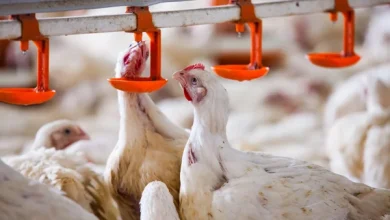Infectious determinants affecting egg quality and production
Dr. Atul Kumar1 and Dr. Varun Sankhyan2 1Assistant Professor, Department of Veterinary Public Health & Epidemiology 2Assistant Professor, Department of Animal Genetics and Breeding Dr. G. C. Negi College of Veterinary and Animal Sciences, CSK HP Agricultural University, Palampur (H.P.) – 176062
- Introduction
Poultry farming is regarded as a highly profitable livestock venture due to the needed demand for its protein by human beings. Because of this, there has always been a massive investment in poultry business both for meat and egg production. Therefore, to meet the demand for eggs by farmers, it is important that farmers meet the optimum nutritional needs of their layers and maintain a conducive and healthy breeding environment. It is equally important that for farmers to make profit, their layer chickens consistently lay quality eggs which are sold to the public for consumption. However, for any animal production or agribusiness like poultry farming, it is quite common to encounter farming cycles where there are intermittent decreases in egg production and general productivity. Moreover, it is frequently difficult to diagnose the cause or causes of reduced egg quality and quantity because it isoften a combination of factors that needs to be investigated and corrected. Management, nutrition and disease alone or in combination are important factors that are responsible for drop in egg production in a poultry farm. This article will address major diseases and syndromes which have been shown, or are reported to, have adverse effects on egg production and quality.
2. Infectious determinant
Any disease of poultry can adversely affect egg production and quality either directly, by having effects on the reproductive system, or indirectly by affecting the health of the bird. Disease micro-organisms that affect poultry include various organisms of bacterial, viral, fungal, protozoan, and parasitic origin. Generally, any disease that affect laying birds consequently results to a reduction of egg production in a poultry flock. This is because once a disease affects a bird’s general well-being, it has a direct outcome on the frequency and quality of egg produced. However, some of the diseases and syndromes are particularly significant in causing reduction and eventual stoppage in the production of eggs in laying birds. These include the following;
A. Avian Salmonellosis: It is caused by the bacteria belonging to genus Salmonella (family Enterobacteriaceae) which consists of more than 2500 serologically distinguishable variants. The serotypes responsible for most of disease in poultry includes Salmonella enterica serovar Gallinarum (fowl typhoid), Salmonella enterica serovar Pullorum (pullorum disease), S. enterica serotype Enteriditis and S. enterica serotype Typhimurium. In general, young birds are more susceptible to Salmonella infections than mature birds. S. Gallinarum and S. Pullorum cause septicaemic disease resulting in decreased egg production and hatchability, as well as morbidity and mortality (Shiva Prasad, 2000). Experimental infection of birds with Salmonella Enteritidis increased the incidence of hairline cracks in eggs, leading to an increased risk of contamination.
B. Fowl Pox: This is a viral disease that has a characteristic scab-like lesion on the unfeathered parts of the body. There is also the wet type (diphtheritic) that affects the mucous membranes of the mouth and the respiratory tract. Fowl pox causes growth disturbance that will lead to poor feed conversion efficiency and a consequent fall in egg production. Fowl pox can be transmitted by contact with affected birds or by biting insects.
C. Newcastle disease: This is also a viral disease that has varying levels of virulence and pathogenicity on layer birds. This variation may lead to a partial to complete drop in egg production or production of thin-shelled eggs. Generally, Newcastle spreads rapidly and can affect the whole flock with clinical signs that include loss of appetite, coughing, depression, dropping wings, paralysis, and greenish watery diarrhea. There are no effective treatments for Newcastle but laying birds could be vaccinated at the appropriate time to prevent against the disease.
D. Avian Influenza: Avian influenza is another viral disease that affects the respiratory, digestive and the nervous systems of birds. The clinical signs of avian influenza include facial swelling, dehydration, cyanosis, coughing, and respiratory distress. The severity of the disease results to a decline in the production of eggs. To prevent avian influenza,good biosecurity measures must be taken at all times on the farm.
E. Infectious Bronchitis: This is a highly contagious viral disease among poultry birds. Infectious bronchitis is characterized by respiratory signs, decreased egg production, poor quality eggs. It is imperative to know that layer birds that have been previously affected by Infectious bronchitis have high probability of being bad layer birds for life. This implies that the birds might never fully get to the optimum productivity of daily and quality egg production.
F. Egg drop syndrome (EDS): Egg drop syndrome is a viral disease caused by duck adenovirus A. Egg drop syndrome affects chickens and quail. Ducks and geese seem to be natural hosts of the virus. The virus is transmitted vertically by eggs. Droppings also contain the virus that can be horizontally transmitted by the oral route. Infected wild birds can be a contamination source for poultry. EDS in layers is accompanied by decrease in egg production and quality. The disease is characterized by drops in egg production and increased incidence of abnormal eggs. Birds remain generally healthy. Egg production is usually reduced by from 10% to 40%. The fall in production can be rapid, and the drop in egg production usually lasts from 4 to 10 weeks.
G. Parasites: Parasites could be internal parasites i.e. endoparasites or external parasites i.e. ectoparasites. Such internal parasites include the roundworms and the tapeworms while the external parasites include lice, northern fowl mites, fleas etc. There are different types of anti-helminthic drugs that are commercially available to effectively and efficiently eliminate these worms. Likewise, there are insecticides and treatment regimens to manage and eliminate ectoparasites from a poultry farm.
H. Coccidiosis: Coccidiosis is a protozoan disease of birds that affects the intestines and causes diarrhea. The disease is said to be found anywhere a poultry farm and production exists. Some of the clinical signs of coccidiosis include emaciation, diarrhea, bloody droppings, and poor feed consumption. These issues invariably lead to a marked drop in egg production in the layer birds. To prevent or manage an incidence of coccidiosis in the layer birds, there are feed additives known as coccidiostat that effectively curbs coccidiosis.
I. Fatty liver haemorrhagic syndrome (FLHS): FLHS is a metabolic disease affecting caged hens in high production. It is characterized by fat infiltration into the liver, haemorrhage and mortality. The disease is associated with a high energy ration and probably induced by mycotoxins, hot weather and dietary lipids. Clinical signs are essentially mortality in full production and sudden drops in egg production. The disease can cause up to 5% mortality during the laying cycle. The liver is friable, enlarged, yellow, engorged with fat and hemorrhagic. Restricted feeding may prevent the disease.
J. Cage layer osteoporosis: Osteoporosis is a metabolic disorder affecting bone structure and reduction in bone mass. The bones are more fragile and susceptible to fractures. The disease may occur with calcium (Ca) depletion. This may occur because of inadequate dietary Ca, vitamin D3 and phosphorus (P) (Julian, 2005). If Ca is insufficient in the diet, in order to produce eggs, hens withdraw the mineral from cortical bone. Phosphorus deficiency causes osteoporosis, often called cage layer fatigue. Phosphorus is essential to the medullary bone structure. Vitamin D3 deficiency results also in osteoporosis by affecting Ca metabolism. Adequate nutrition helps to reduce this disorder. More exercise results also in better bone quality but may not decrease the fracture incidence.
Other diseases that could result in the reduction and stoppage of egg production in layer birds includes, avian encephalomyelitis, Mycoplasma gallisepticum infection, fowl cholera and infectious coryza etc.
3. Poultry disease prevention and management
Routine preventative measures form the next line of defense against disease, after providing a clean and hygienic environment through good poultry farming practices. Preventative measures include: vaccination, parasite control, identifying and treating sick birds, separating multi-age flocks, practicing routine biosecurity procedures between flocks and staff working with them etc.
4. Conclusion
Conclusively, reduction or stoppage in egg production in a poultry farm can be mitigated if adequate attention is paid to good management practices and high-level of biosecurity. A poultry farm with a good biosecurity measures and management protocol will have less scourge of diseases that could cause layer birds to reduce or stop laying eggs which eventually result in economic loss to the farmer.


